|
The three majors indicators are the:
1. Relative Strength Index (RSI)
2. Stochastic Oscillator
3. Moving Average Convergence Divergence (MACD)
Relative Strength Index (RSI):
This index is a popular indicator of the FX market.
The RSI measures the ratio of up-moves to down-moves
and normalises the calculation so that the index is
expressed in a range of 0-100. If the RSI is 70 or
greater then the instrument is seen as overbought
(a situation whereby prices have risen more than market
expectations). An RSI of 30 or less is taken as a
signal that the instrument may be oversold (a situation
whereby prices have fallen more than the market expectations).
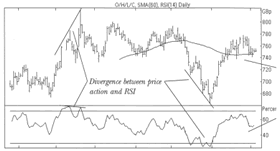
(click on graph to enlarge)
Stochastic Oscillator:
This is used to indicate overbought/oversold conditions
on a scale 0-100%. The indicator is based on the observation
that in a strong up trend, closing prices for periods
tend to concentrate in the higher part of the period’s
range. Conversely, as prices fall in a strong down
trend, closing prices tend to be near to the extreme
low of the period range.
Stochastic calculations produce two lines, %K and
%D which are used to indicate overbought/oversold
areas of a chart. Divergence between the stochastic
lines and the price action of the underlying instrument
gives a powerful trading signal.
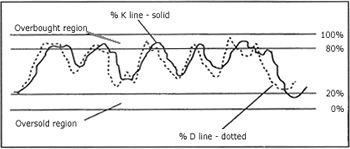
Moving Average Convergence Divergence (MACD):
This indicator involves plotting two momentum lines.
The MACD line is the difference between two exponential
moving averages and the signal or trigger line which
is an exponential moving average of the difference.
If the MACD and trigger lines cross, then this is
taken as a signal that a change in trend is likely.
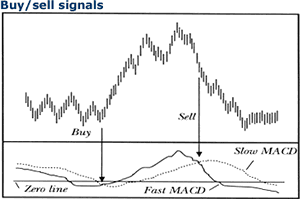
Number theory
Fibonacci numbers:
The Fibinacci number sequence (1,1,2,3,5,8,13,21,34…..)
is constructed by adding the first two numbers to
arrive at the third. The ratio of any number to the
next larger number is 62%, which is a popular Fibonacci
retracement number. The inverse of 62%, which is 38%,
is also used as a Fibonacci retracement number. (used
with the Elliot wave theory, see hereunder)
Gann numbers:
W.D. Gann was a stock and a commodity trader working
in the 50’s who reputedly made over $50Mio in
the markets. He made his fortune using methods which
he developed for trading instruments based on relationships
between price movement and time, known as time/price
equivalents. There is no easy explanation for Gann’s
methods, but in essence he used angles in charts to
determine support and resistance areas and predict
the times of future trend changes. He also used lines
in charts to predict support and resistance areas.
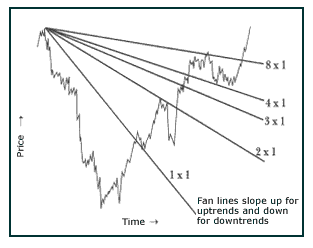
Waves
Elliot wave theory:
The Elliot wave theory is an approach to market analysis
that is based on repetitive wave patterns and the
Fibonacci number sequence. An ideal Elliot wave patterns
shows a five wave advance followed by a three wave
decline.
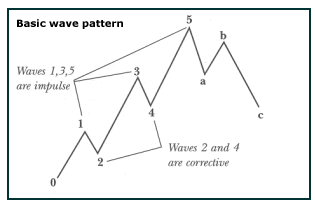
Gaps
Gaps are spaces left on the bar chart where no
trading has taken place.
- An up gap is formed when the lowest price on a
trading day is higher than the highest high of the
previous day.
- A down gap is formed when the highest price of
the day is lower than the lowest price of the prior
day. An up gap is usually a sign of market strength,
while a down gap is a sign of market weakness.
- A breakaway gap is a price gap that forms on the
completion of an important price pattern. It signals
usually the beginning of an important price move.
- A runaway gap is a price gap that usually occurs
around the mid-point of an important market trend.
For that reason, it is also called a measuring gap.
- A exhaustion gap is a price gap that occurs at
the end of an important trend and signals that the
trend is ending.
Trends
A trend refers to the direction of prices. Rising
peaks and troughs constitute an uptrend; falling peaks
and troughs constitute a downtrend, that determine
the steepness of the current trend. The breaking of
a trendline usually signals a trend reversal. A trading
range is characterized by horizontal peaks and troughs.
Moving averages are used to smooth price information
in order to confirm trends and support and resistance
levels. They are also useful in deciding on a trading
strategy particularly in futures trading or a market
with a strong up or down trend.
For simple moving averages, the price is averaged
over a number of days. On each successive day, the
oldest price drops out of the average and is replaced
by the current price- hence the average moves daily.
Exponential and weighted moving averages use the same
technique but weight the figures-least weight to the
oldest price, most to the current.
Chart formations
Examples of chart formations: (triangle, rectangle,
head and shoulders):
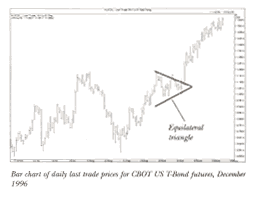


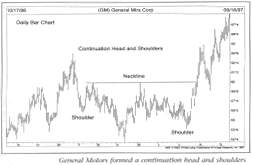
|